
Recently on Cyclingnews.com |
On Test: Louis Garneau cool weather, April 10, 2007
Louis Garneau cool-weather gear & helmet
As central Virginia emerges from the grips of winter, Cyclingnews' Sue George trades in her bulky outer layers for a fresh batch of "cool-weather" cycling gear from Louis Garneau and puts it through a wide range of temperatures from 2°C (36 degrees F) to 24°C (75 degrees F).
Finland Chamois Tights: Superhero duds for the rest of us

|
Louis Garneau's Finland Chamois Tights certainly make a statement with its eighteen separate panels of black "Lycra Power" material joined in contrasting light-gray colored flat-lock seams. Louis Garneau specifically chooses this material (and the construction methods) in order to provide a snugger-than-normal 'compressive fit' which is claimed to reduce all types of fatigue (including strength, endurance, and power) based on a Dupont-sponsored five-year study performed at Penn State University. Compressive fit aside, the rest of the Finland Chamois Tight is fairly normal stuff: elastic grippers line the inner ankle cuffs while the elastic waistband shrouds an adjustable drawstring, and reflective arrows and a logo on the back add nighttime visibility.
Although the tights are also offered chamois-free, our test tights integrated Louis Garneau's most popular gender-specific Ergozone chamois. In our case, pad thickness ranged from 3-8mm, and the text is imprinted right on the chamois, just in case you were wondering. In addition, the thicker parts of the pad are perforated with an array of small holes, which Louis Garneau claims helps with moisture management.
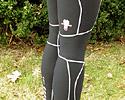
|
Overall, the Finland Chamois Tight proved comfortable on my usual 1-4hr rides (both on- and off-road), and the well-designed multi-panel construction delivered a snugly form-hugging fit that moved with me without sliding relative to my skin. Although I sometimes felt self-conscious wearing tights with stitching that highlighted every curve of my legs (while simultaneously hiding nothing), I was surprised that the conspicuous aesthetics drew relatively few comments from my fellow riders.
Louis Garneau makes a big deal out of the Finland Chamois Tight's impressive performance benefits thanks to its special ingredients. For sure, the Lycra Power material offered up a highly compressive fit, but it didn't seem so tight as to compromise blood circulation in any way [on the contrary, Louis Garneau and DuPont both claim that the concept actually enhances blood flow - Ed.]. That being said, I didn't detect any difference in my own personal performance, but given the decidedly unscientific test environment of the 'real world' (including variations in weather, terrain, and equipment), I'm not sure I expected to.
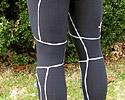
|
Nonetheless, the lightweight fabric did not inhibit movement, but it also did not provide the usual insulation of most tights, either. The highly breathable fabric managed temperatures above 15°C or so (60°F) quite well as my legs never felt overheated; my legs quickly got cold, though, when ambient temperatures were below 10°C (50°F). As a result, the Finland Chamois Tights were most appropriate for days where a simple, light layer on my legs (especially over my knees) was just the thing to fend off a moderate chill in the air, and fulfill their role as a "cool weather" tight handily.
It should be said straight off that I'm not usually a fan of tights with an integrated chamois (especially at this price) since I prefer to use my tights for other activities like running, hiking, and skiing, too. Still, it was nice to have only one waistband instead of the two that result when wearing tights atop your usual pair of shorts.

|
One obvious downside to an integrated chamois, of course, is more frequent washings which almost invariably results in a shorter overall life for the tights. Two months of testing neither proved nor disproved my misgivings, but I still question the tights' durability over the long haul given that the fabric is so thin.
Speaking of the chamois, sitting on the perforated Ergozone pad was like sitting on a piece of Swiss cheese. While this felt odd and unusual, it's not uncomfortable. In fact, the padding performed similarly to others I've ridden and liked, not only in terms of comfort, but also because it seemed to retain a similar amount of moisture and dry (after being washed) in about the same amount of time for given ambient temperature and humidity conditions.
Of course, padding preferences (thickness, location, etc.) are highly subjective, but where the perforations and thickness variations played a positive role was in how they allowed greater articulation of the padding along with my body, thereby still providing a reasonable amount of cushioning and comfort where I needed it while feeling less like a diaper everywhere else.
Price: US$169.99
Pros: Form fitting, light to wear, moves with you, comfortable chamois
Cons: Material retains no warmth, expensive for non-insulated tights
Cyclingnews rating: ![]()
Stretchy fabric and functionality: Speed TS Jacket
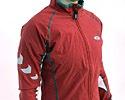
|
The Speed TS Jacket is a lightweight cool-weather shell made from 'Tex Stretch' fabric. According to Louis Garneau, the fabric's 86% nylon/14% spandex blen sets this jacket apart from many others by offering "four-way stretch" (I'd describe it as stretchable in either direction along two axes) that allows for a better fit. In addition, the Speed TS jacket is said to be highly wind resistant and also offers some water repellency.
In use, the Speed TS turned out to be the perfect jacket to add as a top layer on a cool-weather descent or when temperatures drop near the end of a ride. The jacket is not as breathable as a typical long-sleeve jersey, but this can work to its advantage when you want to stay warm while still moving when the temperature is colder; you can build up a little heat and then modulate your core temperature by adjusting the full-length zipper.
On the flip side, the jacket has no insulating capacity, so it will not keep you warm for long if you stop moving for any reason. As for the claimed water repellency, the Speed TS would not be my first pick in a steady rain, but it'll keep out water long enough to finish a short ride in a light mist or drizzle.
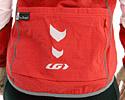
|
My only major nit with the jacket was its claim of "3 back pockets" which can be misleading without additional information. To me, that description implies three relatively equally sized rear pockets distributed across the lower back. However, what it really means is two equally sized standard jersey pockets across the low back with one additional zippered pocket overlaid on top. Yes, the zipper in the "third pocket" does let you stash a key or other valuable item more securely, but no matter how you slice it, two main rear pockets limits load balancing options.
According to Louis Garneau, there was not enough room for more pockets in the rear, but I have plenty of form-fitting jerseys and jackets with three decent-sized pockets across the back, and the larger men's version also features the same pocket distribution. To be fair, most wind shells have few or no pockets, so I felt like I was still coming out ahead here, and it was not generally a problem to stow items in underlying layers.
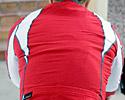
|
The stretchy fabric makes for more of a form-fit under normal use, but it also stretched as needed to become layer number three or four when temperatures up in the mountains dropped more quickly than expected. That said, it also became the perfect emergency jacket, and I found myself taking it everywhere as a backup light layer-riding on roads and trails, commuting, and yes, even running. The jacket's thin fabric also makes it easily stowable.
Aesthetically the red was a nice, yet still visible, change from the usual yellow or orange wind-resistant jacket colors. The coloring was cheerful, yet mercifully less conspicuous for stopping by the post office or library. However, the reflective trim was minimal…I didn't feel comfortable wearing this jacket alone while commuting in the dark around town-the reflective capabilities were relatively insignificant.
Price: US$99.99
Pros: Good for many endurance sports, light, compresses into small form
factor for easy stowing, non-neon color options, stretchy
Cons: limited reflectivity, limited pocket options
Cyclingnews rating: ![]()
More info: www.louisgarneau.com
Photography
For a thumbnail gallery of these images, click here
Images by Sue George/Cyclingnews.com
- It's hard not to feel a bit like Spiderman in the Finland tights.
- The tested pair of Finland tights came with reflective styling and integrated padding…the latter is optional.
- If the outside of these tights doesn't make you feel like Spiderman, the padding inside will.
- The contrasting light-colored flatlock stitching divides these tights into 18 separate panels.
Images by Jonathan Devich/epicimages.us
- The TS Speed jacket viewed at an angle, from the rear shows some white styling highlights.
- Two full sized and one overlapping, smaller zipper pocket gives several storage options for a lightweight shell.
- You can see just how stretchy the Tex Stretch fabric really is…it stretches along two axes.
- The Louis Garneau TS Speed jacket is available in men's and women's sizes.
- The TS Speed jacket features a full zipper and understated styling in the front.
- A view of the zipper garage - a feature now standard on many jackets.

